Detection of COVID-19 in Chest X-ray Images: A Big Data Enabled Deep Learning Approach
Abstract
:1. Introduction
- We propose a novel approach with logistic regression for features extraction and CNN-based architectures of pre-trained VGG19, InceptionV3, and ResNet50 to detect COVID-19 from chest X-rays;
- To the best of our knowledge, our architectures with state-of-art architectures are effective and accurate after using the big-data framework, the Apache Spark in the pipeline;
- We appraise our architectures, classifying 100% in cases of COVID-19 and healthy patient chest X-ray images.
- Finally, our datasets are considerable, consisting of 1063 images for a 3-class classifier and 708 total images for a 2-class classifier.
2. Related Work
3. Materials and Methods
3.1. Coronavirus X-ray Images Dataset
3.1.1. Two-Class Classifier Dataset Description
3.1.2. Three-Class Classifier Dataset Description
3.2. Our Approach
4. Experiment and Results
4.1. Experiment Setup
4.2. Evaluation Metrics
5. Discussion
6. Conclusions
Author Contributions
Funding
Institutional Review Board Statement
Informed Consent Statement
Data Availability Statement
Conflicts of Interest
References
- World Health Organization. Archived: WHO Timeline—COVID-19. 2021. Available online: https://www.who.int/news/item/27-04-2020-who-timeline---covid-19 (accessed on 1 August 2021).
- Cucinotta, D.; Vanelli, M. WHO declares COVID-19 a pandemic. Acta Bio Med. Atenei Parm. 2020, 91, 157. [Google Scholar]
- Nguyen, T.T.; Criss, S.; Dwivedi, P.; Huang, D.; Keralis, J.; Hsu, E.; Phan, L.; Nguyen, L.H.; Yardi, I.; Glymour, M.M. Exploring US shifts in anti-Asian sentiment with the emergence of COVID-19. Int. J. Environ. Res. Public Health 2020, 17, 7032. [Google Scholar] [CrossRef]
- World Health Organization. Coronavirus (Covid-19) Dashboard. 2021. Available online: https://covid19.who.int/.
- Liu, X.-J.; Mesch, G.S. The adoption of preventive behaviors during the COVID-19 pandemic in China and Israel. Int. J. Environ. Res. Public Health 2020, 17, 7170. [Google Scholar] [CrossRef] [PubMed]
- Abbas, A.; Abdelsamea, M.M.; Gaber, M.M.J. Classification of COVID-19 in chest X-ray images using DeTraC deep convolutional neural network. Appl. Intell. 2021, 51, 854–864. [Google Scholar] [CrossRef]
- Wang, L.; Lin, Z.Q.; Wong, A. Covid-net: A tailored deep convolutional neural network design for detection of COVID-19 cases from chest x-ray images. Sci. Rep. 2020, 10, 1–12. [Google Scholar]
- Gozes, O.; Frid-Adar, M.; Greenspan, H.; Browning, P.D.; Zhang, H.; Ji, W.; Bernheim, A.; Siegel, E. Rapid AI development cycle for the coronavirus (COVID-19) pandemic: Initial results for automated detection & patient monitoring using deep learning CT image analysis. arXiv preprint 2020, arXiv:2003.05037. [Google Scholar]
- Wang, S.; Kang, B.; Ma, J.; Zeng, X.; Xiao, M.; Guo, J.; Cai, M.; Yang, J.; Li, Y.; Meng, X.; et al. A deep learning algorithm using CT images to screen for Corona Virus Disease (COVID-19). Eur. Radiol. 2021, 31, 1–9. [Google Scholar] [CrossRef]
- Khumoyun, A.; Cui, Y.; Hanku, L. Spark based distributed deep learning framework for big data applications. In Proceedings of the 2016 International Conference on Information Science and Communications Technologies (ICISCT), Tashkent, Uzbekistan, 2–4 November 2016; pp. 1–5. [Google Scholar]
- Abdullah, A.; Awan, M.; Shehzad, M.; Ashraf, M. Fake News Classification Bimodal using Convolutional Neural Network and Long Short-Term Memory. Int. J. Emerg. Technol. Learn. 2020, 11, 209–212. [Google Scholar]
- Awan, M.J.; Rahim, M.S.M.; Nobanee, H.; Munawar, A.; Yasin, A.; Zain, A.M. Social Media and Stock Market Prediction: A Big Data Approach. Comput. Mater. Contin. 2021, 67, 2569–2583. [Google Scholar] [CrossRef]
- Ahmed, H.M.; Awan, M.J.; Khan, N.S.; Yasin, A.; Shehzad, H.M.F. Sentiment Analysis of Online Food Reviews using Big Data Analytics. Ilkogr. Online 2021, 20, 827–836. [Google Scholar]
- Awan, M.J.; Rahim, M.S.M.; Nobanee, H.; Yasin, A.; Khalaf, O.I.; Ishfaq, U. A big data approach to black friday sales. Intell. Autom. Soft Comput. 2021, 27, 785–797. [Google Scholar] [CrossRef]
- Chen, M.; Mao, S.; Liu, Y. Big data: A survey. Mob. Netw. Appl. 2014, 19, 171–209. [Google Scholar] [CrossRef]
- Shoro, A.G.; Soomro, T.R. Big data analysis: Apache spark perspective. Glob. J. Comput. Sci. Technol. 2015, 15. [Google Scholar]
- Salloum, S.; Dautov, R.; Chen, X.; Peng, P.X.; Huang, J.Z. Big data analytics on Apache Spark. Int. J. Data Sci. Anal. 2016, 1, 145–164. [Google Scholar] [CrossRef] [Green Version]
- Burghard, C. Big data and analytics key to accountable care success. IDC Health Insights 2012, 1, 1–9. [Google Scholar]
- Archenaa, J.; Anita, E.M. Interactive big data management in healthcare using Spark. In Proceedings of the 3rd International Symposium on Big Data and Cloud Computing Challenges (ISBCC–16′), Chennai, India, 10–11 March 2016; pp. 265–272. [Google Scholar]
- Rehma, A.A.; Awan, M.J.; Butt, I. Comparison and Evaluation of Information Retrieval Models. VFAST Trans. Softw. 2018, 6, 7–14. [Google Scholar]
- Alam, T.M.; Awan, M.J. Domain analysis of information extraction techniques. Int. J. Multidiscip. Sci. Eng. 2018, 9, 1–9. [Google Scholar]
- Satyanarayana, L.V. A Survey on challenges and advantages in big data. Int. J. Comput. Sci. Technol. 2015, 6, 115–119. [Google Scholar]
- Raghupathi, W.; Raghupathi, V. Big data analytics in healthcare: Promise and potential. Health Inf. Sci. Syst. 2014, 2, 1–10. [Google Scholar] [CrossRef]
- Wang, K.; Khan, M.M.H. Performance prediction for apache spark platform. In Proceedings of the 2015 IEEE 17th International Conference on High Performance Computing and Communications, 2015 IEEE 7th International Symposium on Cyberspace Safety and Security, 2015 IEEE 12th International Conference on Embedded Software and Systems, New York, NY, USA, 24–26 August 2015; pp. 166–173. [Google Scholar]
- Frampton, M. Mastering Apache Spark; Packt Publishing Ltd.: Birmingham, UK, 2015. [Google Scholar]
- Zaharia, M.; Chowdhury, M.; Das, T.; Dave, A.; Ma, J.; McCauly, M.; Franklin, M.J.; Shenker, S.; Stoica, I. Resilient distributed datasets: A fault-tolerant abstraction for in-memory cluster computing. In Proceedings of the 9th USENIX Symposium on Networked Systems Design and Implementation (NSDI 12), San Jose, CA, USA, 25–27 April 2012; pp. 15–28. [Google Scholar]
- Marcu, O.-C.; Costan, A.; Antoniu, G.; Pérez-Hernández, M.S. Spark versus flink: Understanding performance in big data analytics frameworks. In Proceedings of the 2016 IEEE International Conference on Cluster Computing (CLUSTER), Taipei, Taiwan, 12–16 September 2016; pp. 433–442. [Google Scholar]
- Bengio, Y.; Courville, A.; Vincent, P. Representation learning: A review and new perspectives. IEEE Trans. Pattern Anal. Mach. Intell. 2013, 35, 1798–1828. [Google Scholar] [CrossRef]
- Lee, J.-G.; Jun, S.; Cho, Y.-W.; Lee, H.; Kim, G.B.; Seo, J.B.; Kim, N. Deep Learning in Medical Imaging: General Overview. Korean J. Radiol. 2017, 18, 570–584. [Google Scholar] [CrossRef] [PubMed] [Green Version]
- Benbrahim, H.; Hachimi, H.; Amine, A. Deep transfer learning with apache spark to detect COVID-19 in chest x-ray images. Rom. J. Inf. Sci. Technol. 2020, 23, S117–S129. [Google Scholar]
- Aftab, M.O.; Awan, M.J.; Khalid, S.; Javed, R.; Shabir, H. Executing Spark BigDL for Leukemia Detection from Microscopic Images using Transfer Learning. In Proceedings of the 2021 1st International Conference on Artificial Intelligence and Data Analytics (CAIDA), Riyadh, Saudi Arabia, 6–7 April 2021; pp. 216–220. [Google Scholar]
- Zhang, Y.; Wallace, B. A sensitivity analysis of (and practitioners’ guide to) convolutional neural networks for sentence classification. arXiv 2015, arXiv:1510.03820. [Google Scholar]
- Ouchicha, C.; Ammor, O.; Meknassi, M. CVDNet: A novel deep learning architecture for detection of coronavirus (Covid-19) from chest x-ray images. Chaos Solitons Fractals 2020, 140, 110245. [Google Scholar] [CrossRef] [PubMed]
- Hidaka, A.; Kurita, T. Consecutive dimensionality reduction by canonical correlation analysis for visualization of convolutional neural networks. In Proceedings of the 48th ISCIE International Symposium on Stochastic Systems Theory and its Applications, Fukuoka, Japan, 4–5 November 2016; pp. 160–167. [Google Scholar]
- Yamashita, R.; Nishio, M.; Do, R.K.G.; Togashi, K. Convolutional neural networks: An overview and application in radiology. Insights Imaging 2018, 9, 611–629. [Google Scholar] [CrossRef] [Green Version]
- Talo, M.; Baloglu, U.B.; Yıldırım, Ö.; Acharya, U.R. Application of deep transfer learning for automated brain abnormality classification using MR images. Cogn. Syst. Res. 2019, 54, 176–188. [Google Scholar] [CrossRef]
- Awan, M.J.; Rahim, M.M.S.; Salim, N.; Mohammed, M.A.; Garcia-Zapirain, B.; Abdulkareem, K.H. Efficient Detection of Knee Anterior Cruciate Ligament from Magnetic Resonance Imaging Using Deep Learning Approach. Diagnostics 2021, 11, 105. [Google Scholar] [CrossRef] [PubMed]
- Awan, M.J.; Raza, A.; Yasin, A.; Shehzad, H.M.F.; Butt, I. The Customized Convolutional Neural Network of Face Emotion Expression Classification. Ann. Rom. Soc. Cell Biol. 2021, 25, 5296–5304. [Google Scholar]
- Mujahid, A.; Awan, M.J.; Yasin, A.; Mohammed, M.A.; Damaševičius, R.; Maskeliūnas, R.; Abdulkareem, K.H. Real-Time Hand Gesture Recognition Based on Deep Learning YOLOv3 Model. Appl. Sci. 2021, 11, 4164. [Google Scholar] [CrossRef]
- Anam, M.; Ponnusamy, V.A.; Hussain, M.; Nadeem, M.W.; Javed, M.; Goh, H.G.; Qadeer, S. Osteoporosis Prediction for Trabecular Bone using Machine Learning: A Review. Comput. Mater. Contin. 2021, 67, 89–105. [Google Scholar] [CrossRef]
- Hussain, E.; Hasan, M.; Rahman, A.; Lee, I.; Tamanna, T.; Parvez, M.Z. CoroDet: A deep learning based classification for COVID-19 detection using chest X-ray images. Chaos Solitons Fractals 2021, 142, 110495. [Google Scholar] [CrossRef] [PubMed]
- Turkoglu, M. COVID-19 Detection System Using Chest CT Images and Multiple Kernels-Extreme Learning Machine Based on Deep Neural Network. IRBM 2021, 42, 207–214. [Google Scholar] [CrossRef]
- Elkorany, A.S.; Elsharkawy, Z.F. COVIDetection-Net: A tailored COVID-19 detection from chest radiography images using deep learning. Optik 2021, 231, 166405. [Google Scholar] [CrossRef] [PubMed]
- Das, A.K.; Kalam, S.; Kumar, C.; Sinha, D. TLCoV- An automated Covid-19 screening model using transfer Learning from chest X-ray images. Chaos Solitons Fractals 2021, 144, 110713. [Google Scholar] [CrossRef] [PubMed]
- Zhou, T.; Lu, H.; Yang, Z.; Qiu, S.; Huo, B.; Dong, Y. The ensemble deep learning model for novel COVID-19 on CT images. Appl. Soft Comput. 2021, 98, 106885. [Google Scholar] [CrossRef] [PubMed]
- Hassantabar, S.; Ahmadi, M.; Sharifi, A. Diagnosis and detection of infected tissue of COVID-19 patients based on lung x-ray image using convolutional neural network approaches. Chaos Solitons Fractals 2020, 140, 110170. [Google Scholar] [CrossRef]
- Panwar, H.; Gupta, P.; Siddiqui, M.K.; Morales-Menendez, R.; Singh, V. Application of deep learning for fast detection of COVID-19 in X-Rays using nCOVnet. Chaos Solitons Fractals 2020, 138, 109944. [Google Scholar] [CrossRef]
- Gupta, M.; Jain, R.; Arora, S.; Gupta, A.; Awan, M.J.; Chaudhary, G.; Nobanee, H. AI-enabled COVID-19 outbreak analysis and prediction: Indian States vs. Union Territories. Comput. Mater. Contin. 2021, 67, 933–950. [Google Scholar] [CrossRef]
- Ali, Y.; Farooq, A.; Alam, T.M.; Farooq, M.S.; Awan, M.J.; Baig, T.I. Detection of schistosomiasis factors using association rule mining. IEEE Access 2019, 7, 186108–186114. [Google Scholar] [CrossRef]
- Javed, R.; Saba, T.; Humdullah, S.; Jamail, N.S.M.; Awan, M.J. An Efficient Pattern Recognition Based Method for Drug-Drug Interaction Diagnosis. In Proceedings of the 2021 1st International Conference on Artificial Intelligence and Data Analytics (CAIDA), Riyadh, Saudi Arabia, 6–7 April 2021; pp. 221–226. [Google Scholar]
- Nagi, A.T.; Awan, M.J.; Javed, R.; Ayesha, N. A Comparison of Two-Stage Classifier Algorithm with Ensemble Techniques on Detection of Diabetic Retinopathy. In Proceedings of the 2021 1st International Conference on Artificial Intelligence and Data Analytics (CAIDA), Riyadh, Saudi Arabia, 6–7 April 2021; pp. 212–215. [Google Scholar]
- Awan, M.J.; Yasin, A.; Nobanee, H.; Ali, A.A.; Shahzad, Z.; Nabeel, M.; Zain, A.M.; Shahzad, H.M.F. Fake News Data Exploration and Analytics. Electronics 2021, 10, 2326. [Google Scholar] [CrossRef]
- Kaggle. COVID-19 Chest X-ray Challenge. 2021. Available online: https://www.kaggle.com/bachrr/covid-chest-xray (accessed on 15 January 2020).
- Kaggle. Chest X-ray Images (Pneumonia). 2021. Available online: https://www.kaggle.com/paultimothymooney/chest-xray-pneumonia (accessed on 15 January 2018).
- Khalil, A.; Awan, M.J.; Yasin, A.; Singh, V.P.; Shehzad, H.M.F. Flight Web Searches Analytics through Big Data. Int. J. Comput. Appl. Technol. 2021, in press. [Google Scholar]
- Awan, M.; Khan, R.; Nobanee, H.; Yasin, A.; Anwar, S.; Naseem, U.; Singh, V. A Recommendation Engine for Predicting Movie Ratings Using a Big Data Approach. Electronics 2021, 10, 1215. [Google Scholar] [CrossRef]
- Awan, M.J.; Khan, M.A.; Ansari, Z.K.; Yasin, A.; Shehzad, H.M.F. Fake Profile Recognition using Big Data Analytics in Social Media Platforms. Int. J. Comput. Appl. Technol. 2021, in press. [Google Scholar]
- Dreiseitl, S.; Ohno-Machado, L. Logistic regression and artificial neural network classification models: A methodology review. J. Biomed. Inform. 2002, 35, 352–359. [Google Scholar] [CrossRef] [Green Version]
- Wang, S.-H.; Muhammad, K.; Hong, J.; Sangaiah, A.K.; Zhang, Y.-D. Alcoholism identification via convolutional neural network based on parametric ReLU, dropout, and batch normalization. Neural Comput. Appl. 2020, 32, 665–680. [Google Scholar] [CrossRef]
- He, K.; Zhang, X.; Ren, S.; Sun, J. Deep residual learning for image recognition. In Proceedings of the 2016 IEEE Conference on Computer Vision and Pattern Recognition (CVPR), Las Vegas, NV, USA, 27–30 June 2016; pp. 770–778. [Google Scholar]
- Mahdianpari, M.; Salehi, B.; Rezaee, M.; Mohammadimanesh, F.; Zhang, Y. Very deep convolutional neural networks for complex land cover mapping using multispectral remote sensing imagery. Remote Sens. 2018, 10, 1119. [Google Scholar] [CrossRef] [Green Version]
- Chu, G.; Potetz, B.; Wang, W.; Howard, A.; Song, Y.; Brucher, F.; Leung, T.; Adam, H. Geo-aware networks for fine-grained recognition. In Proceedings of the IEEE/CVF International Conference on Computer Vision Workshops, Seoul, Korea, 27 October–2 November 2019; pp. 247–254. [Google Scholar]
- Pan, X.; Luo, P.; Shi, J.; Tang, X. Two at once: Enhancing learning and generalization capacities via ibn-net. In Proceedings of the European Conference on Computer Vision (ECCV), Munich, Germany, 8–14 September 2018; pp. 464–479. [Google Scholar]
- Tahir, H.; Iftikhar, A.; Mumraiz, M. Forecasting COVID-19 via Registration Slips of Patients using ResNet-101 and Performance Analysis and Comparison of Prediction for COVID-19 using Faster R-CNN, Mask R-CNN, and ResNet-50. In Proceedings of the 2021 International Conference on Advances in Electrical, Computing, Communication and Sustainable Technologies (ICAECT), Bhilai, India, 19–20 February 2021; pp. 1–6. [Google Scholar]
- Wang, M.; Gong, X. Metastatic cancer image binary classification based on resnet model. In Proceedings of the 2020 IEEE 20th International Conference on Communication Technology (ICCT), Nanning, China, 28–31 October 2020; pp. 1356–1359. [Google Scholar]
- Mateen, M.; Wen, J.; Song, S.; Huang, Z. Fundus image classification using VGG-19 architecture with PCA and SVD. Symmetry 2019, 11, 1. [Google Scholar] [CrossRef] [Green Version]
- Ilijason, R. Getting Started with Databricks. In Beginning Apache Spark Using Azure Databricks; Springer: Berlin/Heidelberg, Germany, 2020; pp. 27–38. [Google Scholar]
- Awan, M.; Rahim, M.; Salim, N.; Ismail, A.; Shabbir, H.J. Acceleration of knee MRI cancellous bone classification on Google colaboratory using convolutional neural network. Int. J. Adv. Trends Comput. Sci. 2019, 8, 83–88. [Google Scholar] [CrossRef]
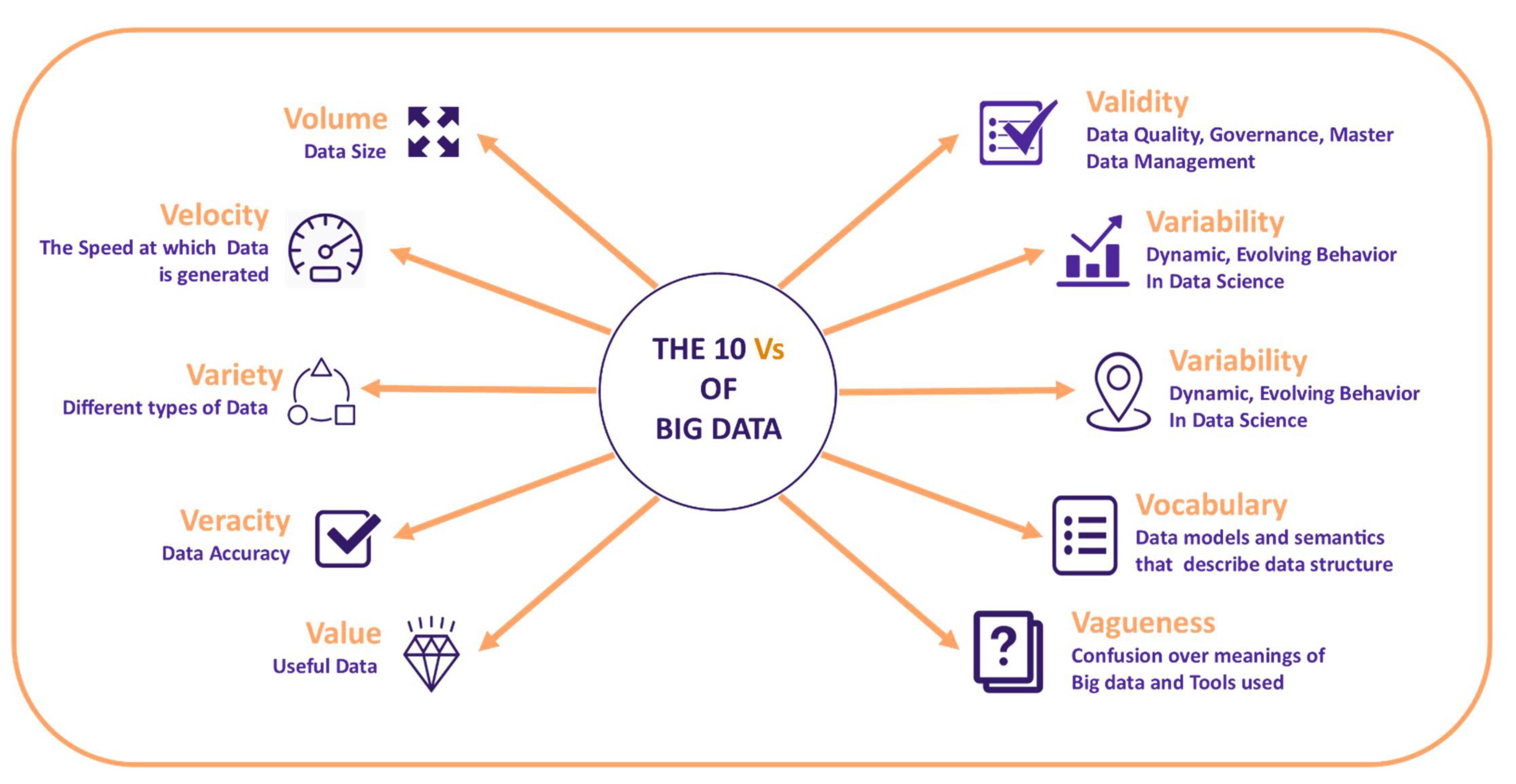

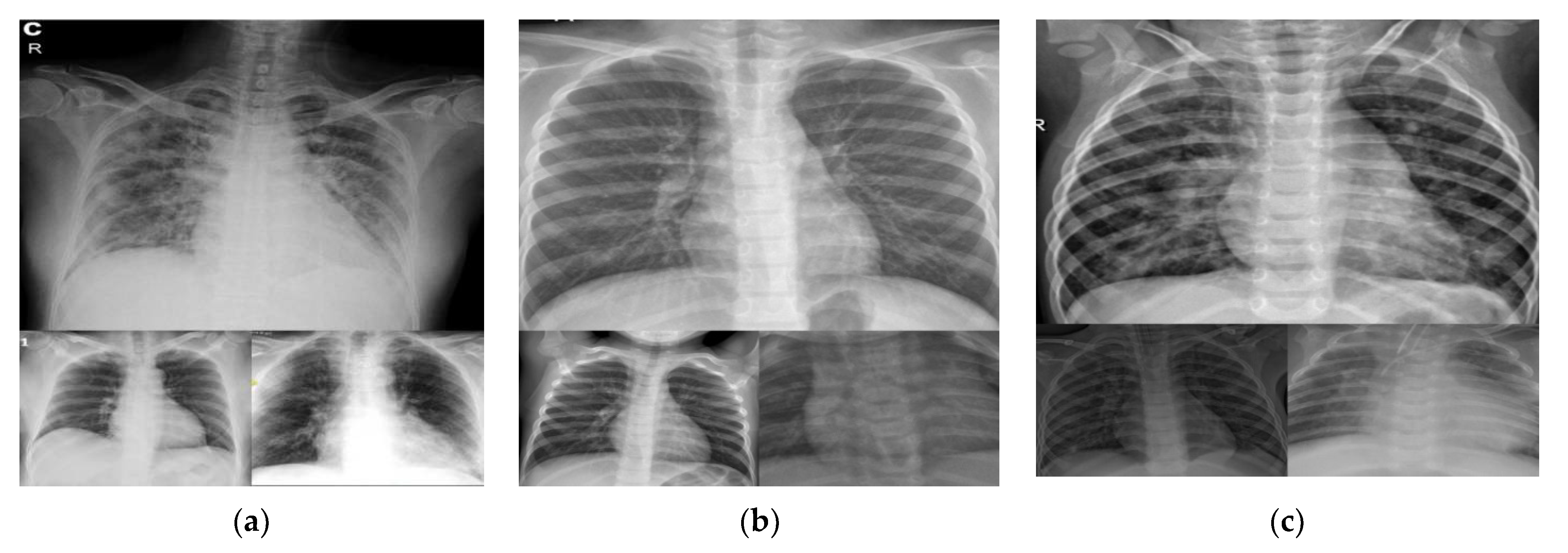
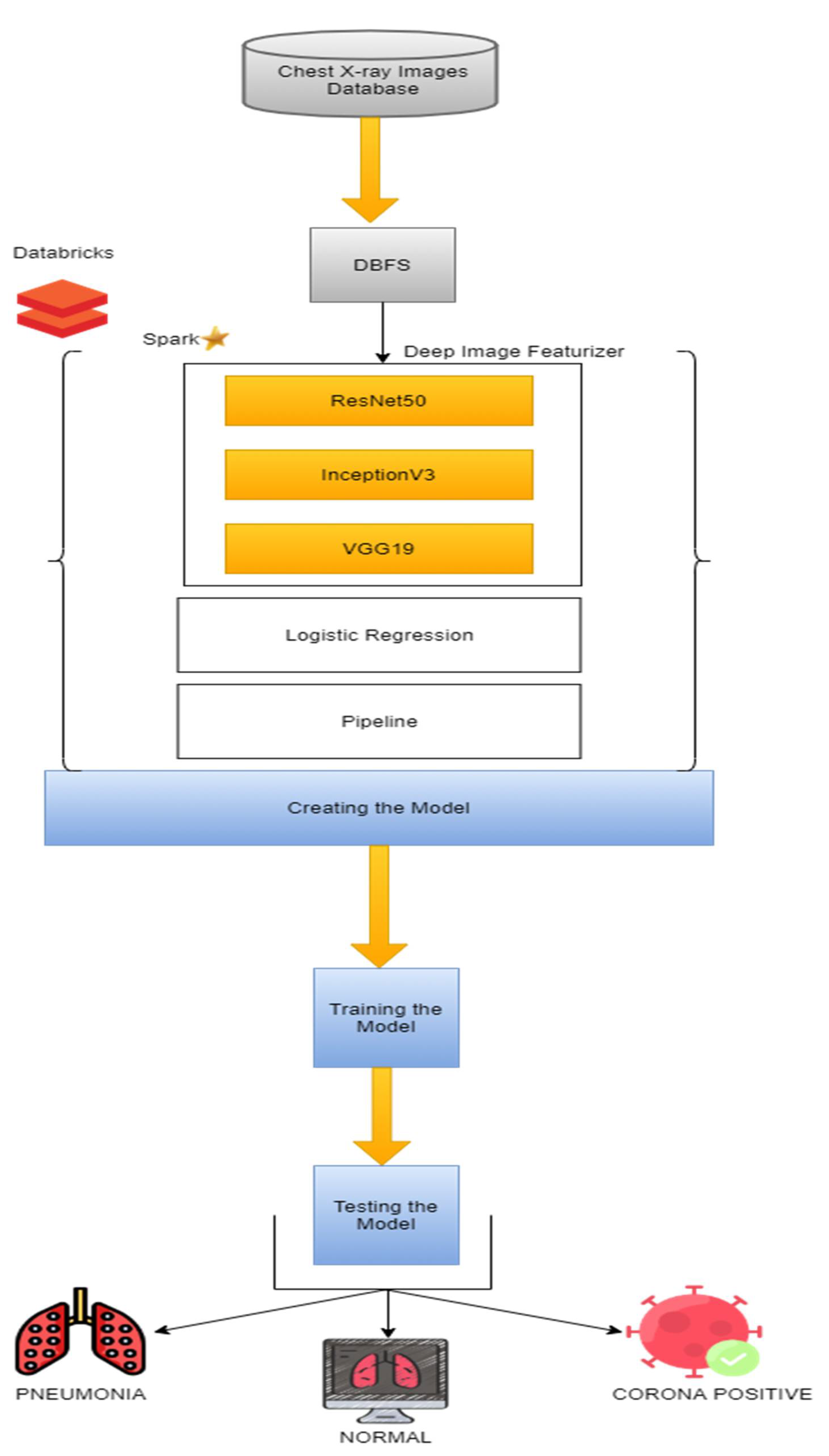
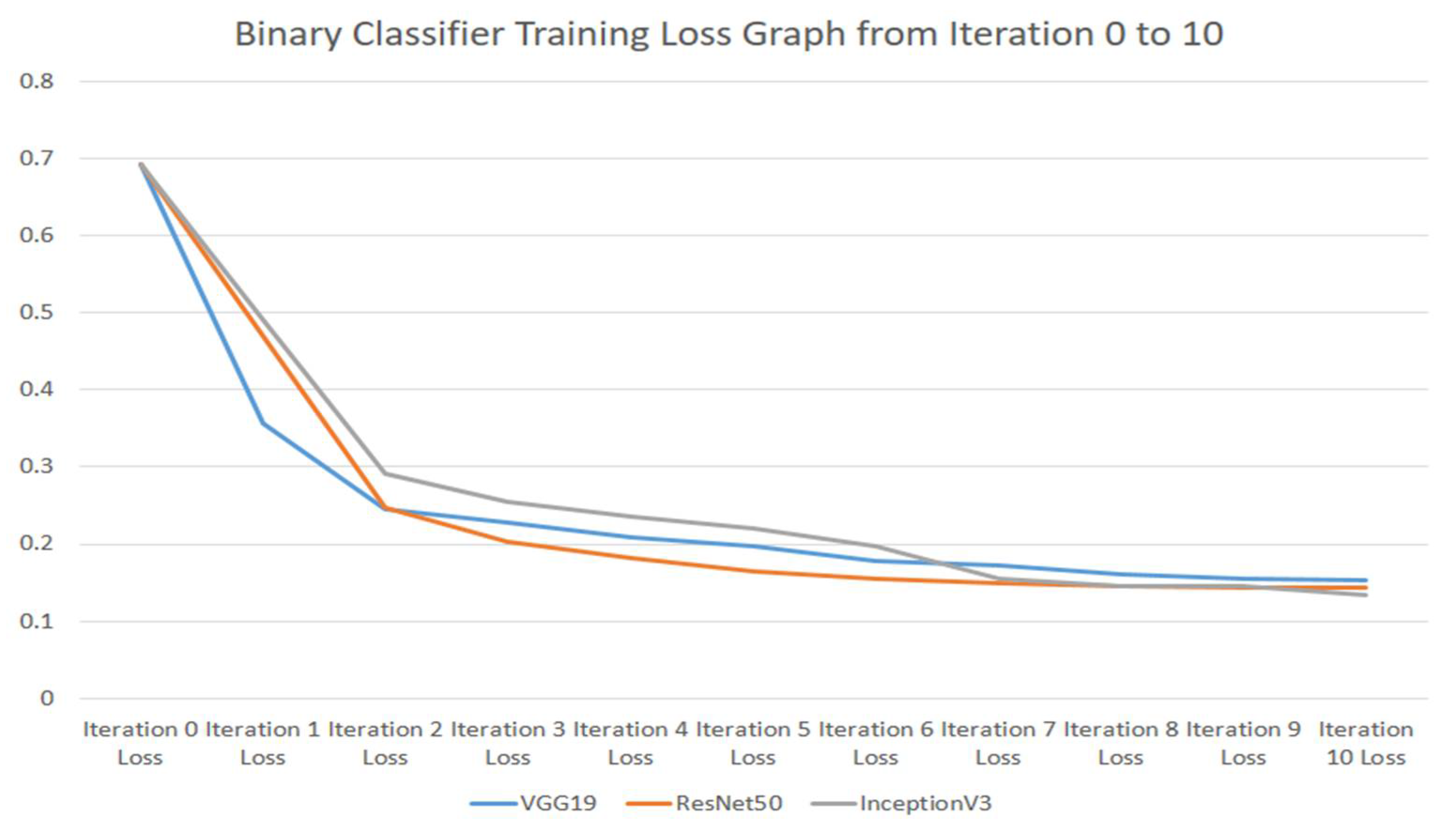

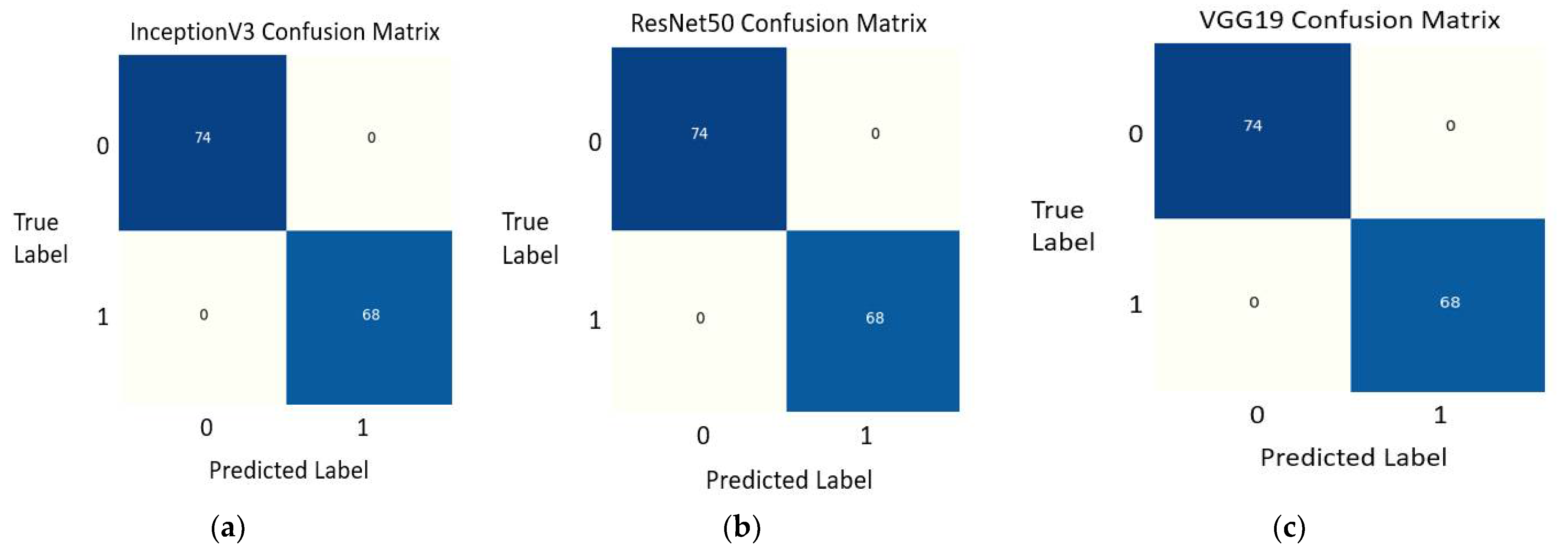



| The Classes | Number of Images |
|---|---|
| COVID-19 | 354 |
| Normal | 354 |
| The Classes | Number of Images |
|---|---|
| COVID-19 | 354 |
| Normal | 354 |
| Pneumonia | 355 |
| Model | Classes | Mean Accuracy | Precision | Recall | Mean AUC |
|---|---|---|---|---|---|
| Inception V3 | COVID-19, Normal | 1 | 1 | 1 | 1 |
| COVID-19, Normal, Pneumonia | 97.10% | 0.9713 | 0.9710 | 0.9784 | |
| ResNet50 | COVID-19, Normal | 1 | 1 | 1 | 1 |
| COVID-19, Normal, Pneumonia | 98.55% | 0.9855 | 0.9855 | 0.9890 | |
| VGG19 | COVID-19, Normal | 1 | 1 | 1 | 1 |
| COVID-19, Normal, Pneumonia | 98.55% | 0.9855 | 0.9855 | 0.9893 |
| Author, Year | Architecture | 2 Class | 3 Class | 4 Class |
|---|---|---|---|---|
| Hussain et al., 2021 [51] | Novel CNN Model CoroDet | 99.1% | 94.2% | 91.2% |
| M. Turkoglu, 2021 [52] | ELM and Deep Neural Network | - | 98.36% | - |
| Das et al., 2021 [54] | CNN, VGG-16 ad ResNet-50 | - | VGG = 97.67% ResNet-50 = 96.41% CNN = 93.67% | - |
| Zhou et al., 2021 [55] | AlexNet, GoogleNet, ResNet and SoftMax for Classification | - | GoogleNet = 98.25% ResNet = 98.56% SoftMax = 98.56% The ensemble model outperformed the component classifier. | - |
| Hassantabar et al., 2020 [56] | Deep Neural Network (DNN) and Convolutional Neural network (CNN) | CNN = 93.2% DNN = 83.4% | - | - |
| Panwar et al., 2020 [57] | Deep learning neural network model using nCOVnet algorithm | 97.97% | - | - |
| Proposed Model | InceptionV3, ResNet50, VGG19 | Inception V3 = 100% ResNet50 = 100% VGG19 = 100% | Inception V3 = 97% ResNet50 = 98.55% VGG19 = 98.55% | - |
Publisher’s Note: MDPI stays neutral with regard to jurisdictional claims in published maps and institutional affiliations. |
© 2021 by the authors. Licensee MDPI, Basel, Switzerland. This article is an open access article distributed under the terms and conditions of the Creative Commons Attribution (CC BY) license (https://creativecommons.org/licenses/by/4.0/).
Share and Cite
Awan, M.J.; Bilal, M.H.; Yasin, A.; Nobanee, H.; Khan, N.S.; Zain, A.M. Detection of COVID-19 in Chest X-ray Images: A Big Data Enabled Deep Learning Approach. Int. J. Environ. Res. Public Health 2021, 18, 10147. https://doi.org/10.3390/ijerph181910147
Awan MJ, Bilal MH, Yasin A, Nobanee H, Khan NS, Zain AM. Detection of COVID-19 in Chest X-ray Images: A Big Data Enabled Deep Learning Approach. International Journal of Environmental Research and Public Health. 2021; 18(19):10147. https://doi.org/10.3390/ijerph181910147
Chicago/Turabian StyleAwan, Mazhar Javed, Muhammad Haseeb Bilal, Awais Yasin, Haitham Nobanee, Nabeel Sabir Khan, and Azlan Mohd Zain. 2021. "Detection of COVID-19 in Chest X-ray Images: A Big Data Enabled Deep Learning Approach" International Journal of Environmental Research and Public Health 18, no. 19: 10147. https://doi.org/10.3390/ijerph181910147
APA StyleAwan, M. J., Bilal, M. H., Yasin, A., Nobanee, H., Khan, N. S., & Zain, A. M. (2021). Detection of COVID-19 in Chest X-ray Images: A Big Data Enabled Deep Learning Approach. International Journal of Environmental Research and Public Health, 18(19), 10147. https://doi.org/10.3390/ijerph181910147







